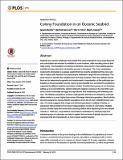Por favor, use este identificador para citar o enlazar a este item:
http://hdl.handle.net/10261/132463COMPARTIR / EXPORTAR:
 SHARE SHARE
 CORE
BASE CORE
BASE
|
|
| Visualizar otros formatos: MARC | Dublin Core | RDF | ORE | MODS | METS | DIDL | DATACITE | |

| Campo DC | Valor | Lengua/Idioma |
|---|---|---|
| dc.contributor.author | Munilla, Ignacio | - |
| dc.contributor.author | Genovart, Meritxell | - |
| dc.contributor.author | Paiva, Vitor H. | - |
| dc.contributor.author | Velando, Alberto | - |
| dc.date.accessioned | 2016-05-20T10:41:53Z | - |
| dc.date.available | 2016-05-20T10:41:53Z | - |
| dc.date.issued | 2016-02-24 | - |
| dc.identifier | doi: 10.1371/journal.pone.0147222 | - |
| dc.identifier | issn: 1932-6203 | - |
| dc.identifier.citation | PLoS ONE 11(2):e0147222 (2016) | - |
| dc.identifier.uri | http://hdl.handle.net/10261/132463 | - |
| dc.description.abstract | Seabirds are colonial vertebrates that despite their great potential for long-range dispersal and colonization are reluctant to establish in novel locations, often recruiting close to their natal colony. The foundation of colonies is therefore a rare event in most seabird species and little is known about the colonization process in this group. The Cory's shearwater (Calonectris diomedea) is a pelagic seabird that has recently established three new colonies in Galicia (NE Atlantic) thus expanding its distribution range 500 km northwards. This study aimed to describe the establishment and early progress of the new Galician populations and to determine the genetic and morphometric characteristics of the individuals participating in these foundation events. Using 10 microsatellite loci, we tested the predictions supported by different seabird colonization models. Possibly three groups of non-breeders, adding up to around 200 birds, started visiting the Galician colonies in the mid 2000's and some of them eventually laid eggs and reproduced, thus establishing new breeding colonies. The Galician populations showed a high genetic diversity and a frequency of private alleles similar to or even higher than some of the large historical populations. Most individuals were assigned to several Atlantic populations and a few (if any) to Mediterranean colonies. Our study suggests that a large and admixed population is settling in Galicia, in agreement with predictions from island metapopulation models of colonization. Multiple source colonies imply that some birds colonizing Galicia were dispersing from very distant colonies (> 1500 km). Long-distance colonizations undertaken by relatively large and admixed groups of colonizers can help to explain the low levels of genetic structure over vast areas that are characteristic of most oceanic seabird species. | - |
| dc.description.sponsorship | This study was funded annually (2010–2013) by the Organismo Autónomo de Parques Nacionales of Spain (http://www.magrama.gob.es/es/parques-nacionales-oapn/programa-investigacion/) through the research project 079/2009. Financial support for the fieldwork in Azores, Madeira, Selvagens and Berlengas was provided by the EU project LIFE04NAT/PT/000213, coordinated by SPEA (Sociedade Portuguesa para o Estudo das Aves), the BirdLife International partner in Portugal. HP acknowledges the support given by the Fundação para a Ciência e Tecnologia (Portugal, SFRH/BD/21557/2005 and SFRH/BPD/85024/2012). Financial support for the fieldwork in Cima Islet was provided by the EU project LIFE09NAT/PT/000041 | - |
| dc.publisher | Public Library of Science | - |
| dc.relation.isversionof | Publisher's version | - |
| dc.rights | openAccess | - |
| dc.title | Colony foundation in an oceanic seabird | - |
| dc.type | artículo | - |
| dc.identifier.doi | 10.1371/journal.pone.0147222 | - |
| dc.relation.publisherversion | http://dx.doi.org/10.1371/journal.pone.0147222 | - |
| dc.date.updated | 2016-05-20T10:41:53Z | - |
| dc.description.version | Peer Reviewed | - |
| dc.language.rfc3066 | eng | - |
| dc.rights.license | http://creativecommons.org/licenses/by/4.0/ | - |
| dc.contributor.funder | European Commission | - |
| dc.contributor.funder | Fundação para a Ciência e a Tecnologia (Portugal) | - |
| dc.contributor.funder | Sociedade portuguesa para o estudo das aves | - |
| dc.contributor.funder | Organismo Autónomo Parques Nacionales (España) | - |
| dc.relation.csic | Sí | - |
| dc.identifier.funder | http://dx.doi.org/10.13039/501100000780 | es_ES |
| dc.identifier.funder | http://dx.doi.org/10.13039/501100001871 | es_ES |
| dc.identifier.pmid | 26909694 | - |
| dc.type.coar | http://purl.org/coar/resource_type/c_6501 | es_ES |
| item.openairetype | artículo | - |
| item.grantfulltext | open | - |
| item.cerifentitytype | Publications | - |
| item.openairecristype | http://purl.org/coar/resource_type/c_18cf | - |
| item.fulltext | With Fulltext | - |
| Aparece en las colecciones: | (IMEDEA) Artículos | |
Ficheros en este ítem:
| Fichero | Descripción | Tamaño | Formato | |
|---|---|---|---|---|
| Munilla-PLoSOne-2016-e0147222.PDF | 2,21 MB | Adobe PDF |  Visualizar/Abrir |
CORE Recommender
PubMed Central
Citations
2
checked on 13-abr-2024
SCOPUSTM
Citations
22
checked on 15-abr-2024
WEB OF SCIENCETM
Citations
21
checked on 25-feb-2024
Page view(s)
206
checked on 23-abr-2024
Download(s)
192
checked on 23-abr-2024

